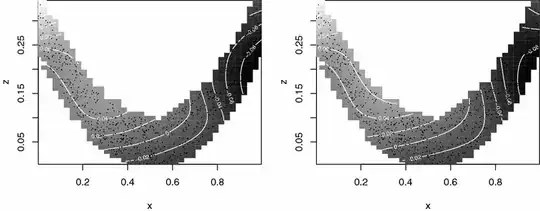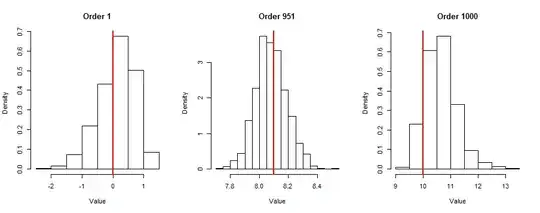I want to perform a bootstrap/simulation of the significance of a KS test in some observed data and have come up with some synthetic examples to make sure my code works, which I base off Greg Snow's answer here, off Clauset et al. 2009's approach, and off Colin Gillespie's poweRlaw package. The real data follows a truncated lognormal distribution, for reference. I don't see any questions that cover exactly what I do here. I want to be sure my approach and code are correct, given the observation on the histogram of p-values at the end.
Say I have some values, X, of length N, I know follow a given distribution, say lognormal, but I don't know the parameters, theta. I estimate the parameters using MLE, theta_est, and then compute the KS-statistic, KS_est, of the fitted distribution. Now I want to evaluate the goodness of fit but I know that the Kolmogorov distribution is biased in the case of estimated parameters. I turn to simulation and do the following.
For M simulations:
simulate N lognorm values with parameters theta_est.
alternative 1: compute KS-statistic of simulated data (KS_sim1) & p-value using theta_est.
alternative 2: Estimate new parameters for simulated data, theta_hat, and then compute KS_sim2 using theta_hat.
end
Alternative 2 is the 'correct' way according to Clauset, Greg Snow's answer, other answers from Glen_b, unless I am mistaken. I do this, and I find that the CDF of KS_sim1 and the Kolmogorov distribution (KS_analytical) closely match each other, while the CDF of KS_sim2 is shifted to the left and much steeper. This means that the estimated p-value [ P(KS_est > KS_sim) ] is much lower for KS_sim2 and for KS_analytical. I want to believe alternative 2, but then I check the histogram of simulated p-values, and find that the histogram is uniform for alternative 1 but not for alternative 2! Where is my mistake? In fact the p-value histogram is very skewed for alternative 2. Is it because I am computing the p-value from KS_analytical? Any insight, and recommended reading would be greatly appreciated.
library(fitdistrplus)
library(kolmim)
randlnorm <- rlnorm(1000, 4, 1)
hist(randlnorm,breaks="FD")
plot(ecdf(randlnorm))
flnorm <- fitdistrplus::fitdist(randlnorm, 'lnorm')
pv <- ks.test(randlnorm, 'plnorm', meanlog = flnorm$estimate[1], sdlog = flnorm$estimate[2])
lnorm_sim_KS <- sapply(1:2500, function(i) {
randlnorm_sim <- rlnorm(length(randlnorm), meanlog = flnorm$estimate[1], sdlog = flnorm$estimate[2])
flnorm_sim <- fitdistrplus::fitdist(randlnorm_sim, 'lnorm')
pv_sim <- ks.test(randlnorm_sim, 'plnorm', meanlog = flnorm$estimate[1], sdlog = flnorm$estimate[2])
pv_sim2 <- ks.test(randlnorm_sim, 'plnorm', meanlog = flnorm_sim$estimate[1], sdlog = flnorm_sim$estimate[2])
return(c(pv_sim$statistic, pv_sim$p.value, pv_sim2$statistic, pv_sim2$p.value))
})
KS_toeval <- seq(.001, .05, by = .001)
Fks_anal <- kolmim::pkolmim(KS_toeval, length(randlnorm))
# CDF of KS
plot(KS_toeval, Fks_anal, xlim = c(0, 0.05), type = "l",
ylim = c(0, 1), lwd = 3, main = bquote(F[x]*(KS)), xlab = "KS-statistic",
cex.lab = 1.6, cex.axis = 1.6, cex.main = 1.6, ylab = bquote(F[x]))
grid(lwd = 2, col = rgb(0.05, 0.05, 0.05, 0.5))
lines(ecdf(lnorm_sim_KS[1, ]), lwd = 3, col = "blue")
lines(ecdf(lnorm_sim_KS[3, ]), lwd = 3, col = "red")
legend("topleft", lwd = 3, lty = 1, col = c('black', 'blue', 'red'),
legend = c('Analytical Kolmogorov', 'const. par sim.', 'est. par sim.'))
abline(v= pv$statistic, lwd = 3, lty = 2)
par(mfrow=c(2, 1))
hist(lnorm_sim_KS[2, ], xlab = "p-val alternative 1")
hist(lnorm_sim_KS[4, ], xlab = "p-val alternative 2")
> mean(lnorm_sim_KS[1, ] >= pv$statistic)
[1] 0.602
> mean(lnorm_sim_KS[3, ] >= pv$statistic)
[1] 0.178
> pv$p.value
[1] 0.5938039

